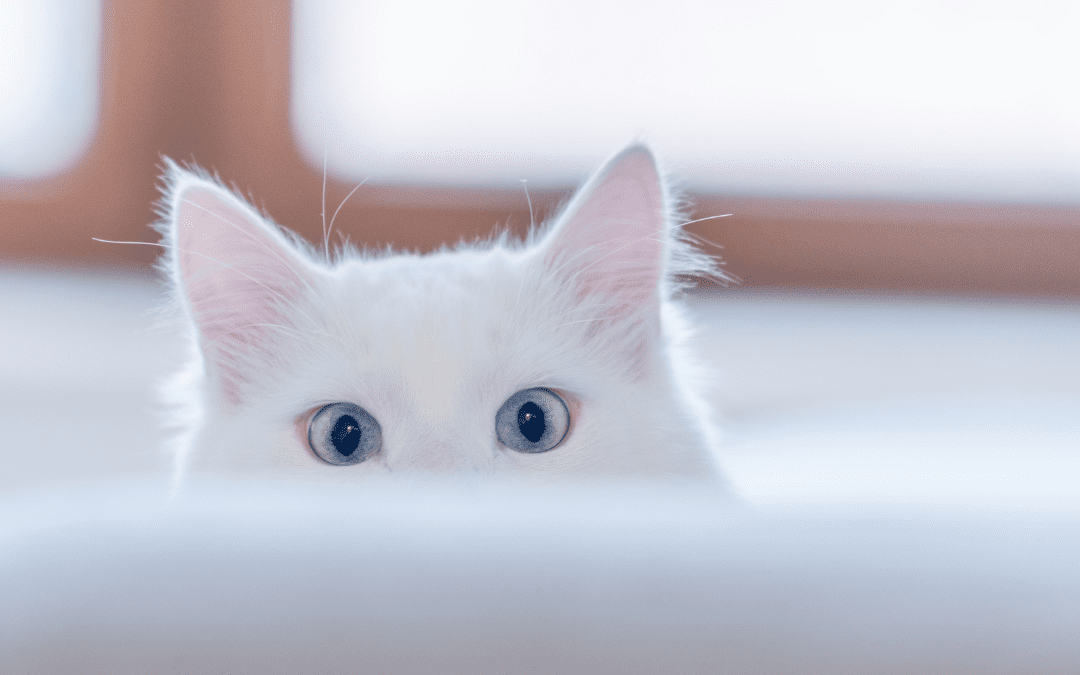By Rebecca MacMillan BVetMed BSAVA PGCertSAM MRCVS
Have you started noticing your cat making some extra noise lately? Cats are usually very quiet when they breathe so it can be a worry if you start to notice a few unusual sounds. Let’s explore the reasons why your cat’s breathing might be noisy and what you can do to help.
What is normal breathing in cats?
First of all, let’s think about what normal breathing is in cats. Cats are nose-breathers and will very rarely pant or breath through their mouths unless they are very stressed, overheating, or unwell.
Their breathing should be quiet, only audible if you listen very closely. Similarly, you shouldn’t see much movement when they are breathing either. The normal respiratory rate in a resting cat is 16-40 breaths per minute. Any more than this might need investigating.
A normal healthy cat will have a clean nose (no discharge or crusting), no coughing or excessive sneezing and will have a healthy-sounding meow and purr.
How do you know if a cat is breathing noisily?
First of all, there are two main types of noisy breathing in cats. These are –
Stridor: A high-pitched sound when breathing noisily, often caused by a problem with rigid tissues such as the larynx (entrance to the windpipe) or trachea (windpipe).
Stertor: Low-pitched sounds that often occur due to problems with softer tissues. Problems with the nasal passages and soft palate at the back of the throat can cause stertorous sounds, especially when the cat is inhaling.
The following are examples of the types of sounds that cats with noisy breathing might make, all of which could indicate an underlying health issue –
- Wheezing
- Gurgling noises
- Coughing or gagging
- Snoring
- Snorting
- Excessive sneezing
- Panting or gasping
Cats with respiratory problems may also have the following symptoms in addition to increased breathing noise –
- Nose or eye discharge
- A change in vocalisation (‘losing’ their meow or sounding hoarse)
- Increased effort when breathing (you can see their abdomen moving more than usual)
- Faster respiratory rate (more breaths per minute than usual)
- Abnormal postures (holding their neck extended, or holding their elbows away from their sides to allow maximum air into their lungs)
- Nosebleeds (epistaxis)
- Lethargy
- Changes in appetite
- Fever
- Pale gums
- Episodes of weakness or collapse
If your cat is showing any of the above symptoms, then you must get them seen by a vet urgently.
What causes noisy breathing in cats?
Many conditions can cause cats to breathe noisily. Some of the more common ones include –
- Infection – such as feline herpes virus and feline calicivirus (viruses that cause ‘cat flu’)
- Feline asthma – a chronic allergic respiratory disease, leading to inflammation in your cat’s airways
- A foreign body – grass or grass seeds stuck in the throat or nose can cause a cat to make more sound, as well as gag and cough
- Nasopharyngeal polyps – benign soft tissue growths in the nasal passage or back of the throat
- Heart problems – an enlarged heart could press on the windpipe causing issues, as well as fluid in the lungs seen in heart failure
- Laryngeal disease – problems with the larynx in the back of the throat that helps control airflow into the lungs
- Trauma – e.g. being hit by a car or attacked by a dog
- Brachycephalic breeds – Cats that have flattened faces and narrowed nostrils will have more difficulty breathing, with snoring and snorting common.
- Dental disease – issues with tooth roots could have a knock-on effect on the nasal passages
- Cancer – tumours could arise in any location of the respiratory tract leading to a disruption of airflow, the most common type is lymphoma.
What should I do if I think my cat’s breathing is noisy?
If your cat has noisy breathing, then call your vet for an appointment. Problems are best dealt with sooner rather than later, as this leads to better outcomes. As you have seen, there is a long list of potential causes for noisy breathing, so a proper diagnosis from a vet is needed. It is also worth noting that cats are very good at hiding signs of disease until problems are very serious, so detecting early changes is important.
What will the vet do to help my cat?
The vet will start by examining your cat, to check for any external clues such as discharge from the nose, narrowed nostrils or any changes in respiratory rate and effort. They will listen to your cat’s chest with a stethoscope to check their heart and lungs, record their temperature and get an accurate weight for them.
The next steps will depend on their findings. If the immediate cause of the problem is not obvious then your vet may recommend investigating further. This may involve blood samples to check organ function and for markers of infection and inflammation. Blood samples can also be screened for feline leukaemia virus and feline immunodeficiency virus, which make cats more prone to upper respiratory issues. Swabs of your cat’s nose and throat may be useful to look for infectious causes of disease.
Examining your cat’s throat under sedation can be useful to look for growths or foreign bodies. X-rays or CT scans can help to look for physical changes in the airways such as tumours, trauma or lung disease. Rhinoscopy (passing a small rigid) camera into the airways may be recommended. Samples from the airways can also be taken by performing a nasal flush or bronchoalveolar lavage, depending on where the issue is. This is a way of flushing small amounts of sterile saline into the airway, drawing it back out again so that cells can be collected which might diagnose certain conditions.
Will my cat be ok?
The prognosis for your cat will very much depend on the condition that they have been diagnosed with. For example, a cat with a blade of grass stuck in the back of their throat will be easily cured by having this removed, whereas a cat that is in congestive heart failure or that has an aggressive tumour on their larynx will have a much poorer long-term prognosis. Other conditions like feline asthma can be successfully managed with the right combination of medications and changes to the home environment.
Your vet will guide you through the various treatment options for your cat’s condition based on the findings of their examination and any tests.
Summary
Noisy breathing in cats is something that should be taken seriously, as it usually indicates an underlying health problem. Getting your cat seen by a vet promptly is important as some conditions can deteriorate rapidly. The quicker your pet is examined, the quicker appropriate treatment can be started, making your pet much more comfortable again.
FAQs
Why is my cat breathing so loud?
There are many reasons why your cat’s breathing is noisy. These include his breed (flat-faced cats have airways that make breathing more difficult), viral and bacterial infections, tumours, asthma, foreign bodies or heart problems. Because there are so many possible reasons, it’s always best to get things checked out by a vet.
Why does my cat sound gurgly?
If your cat is making gurgly sounds when they breathe, this could be due to an increase in mucus or fluid somewhere in his respiratory tract. Cats are usually quiet breathers, so any changes in sound like this need to be investigated by a vet.
Should you transport a cat with a breathing problem?
While it is not ideal to transport a cat with a severe breathing issue, it may be the only chance they have at survival. There is a limit as to what a vet can do in your home, so getting your cat to a hospital in a stress-free manner is important. If your vet advises you to bring them in for an exam then try to handle your cat as gently as possible and cover his carrier with a light blanket or towel to make him feel more secure on the journey.
You can find out more about supporting your cat’s respiratory health here.

